Hinduism in Sri Lanka
Hinduism is one of Sri Lanka's oldest religions, with temples dating back over 2,000 years. As of 2011, Hindus made up 12.6 percent[1] of the Sri Lankan population. They are almost exclusively Tamils, except for small immigrant communities from India and Pakistan (including the Sindhis, Telugus and Malayalees).
இலங்கையில் இந்து மதம் ශ්රී ලංකාවේ හින්දු ධර්මය | |
|---|---|
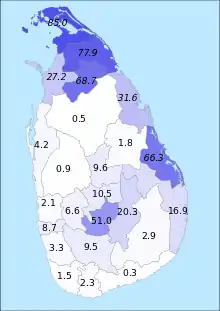 Distribution of Hindus in Sri Lanka | |
| Total population | |
| 2.5 million (12.6%) (2012) () | |
| Regions with significant populations | |
| Northern Province, Eastern Province, Central Province | |
| Languages | |
| Sri Lankan languages | |
| Religion | |
| Shaivism | |
| Related ethnic groups | |
| Tamil |
| Part of a series on |
| Hinduism |
|---|
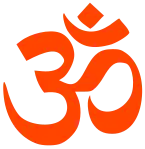 |
|
| Hinduism by country |
|---|
  |
| Full list |
According to the 1915 census, Hindus made up about 25 percent of the Sri Lankan population (including indentured labourers brought by the British). Hinduism predominates in the Northern and Eastern Provinces (where Tamils remain the largest demographic), the central regions and Colombo, the capital. According to the 2011 census, there are 2,554,606 Hindus in Sri Lanka (12.6 percent of the country's population). During the Sri Lankan Civil War, many Tamils emigrated; Hindu temples, built by the Sri Lankan Tamil diaspora, maintain their religion, tradition and culture.
Most Sri Lankan Hindus follow the Shaiva Siddhanta school of Shaivism, and some follow Shaktism. Sri Lanka is home to the five abodes of Shiva: Pancha Ishwarams, holy places built by King Ravana. Murugan is one of the country's most popular Hindu deities, venerated by Hindu Tamils[2] also the Buddhist Sinhalese and Aboriginal Veddas venerate the local rendition of the deity, Katharagama deviyo.[3]
Yogaswami of Jaffna is a significant modern Hindu religious figure in Sri Lankan history. A 20th-century mystic, he was the satguru and counselling sage of the country's Tamil Hindu population. The Ramakrishna Mission is active in the Amparai and Batticaloa districts, and the Shaiva Siddhanta school is prevalent in the north.[4] Yogaswami was the 161st head of the Nandinatha Sampradaya, and was succeeded by Sivaya Subramuniyaswami.[5]
Legendary origins
The first major Hindu reference to Sri Lanka is found in the epic Ramayana. Sri Lanka was ruled by the Yaksha King Kubera. The throne of Lanka was usurped by Kubera's half-brother Ravana, the epic's chief antagonist, who was killed by Rama (the seventh avatar of Vishnu). The Ramayana also mentions Rama's Bridge, between India and Sri Lanka, which was built with rocks by Rama with the aid of Hanuman and others. Many believers see the chain of sandbars, connecting Sri Lanka to India in satellite images, as remnants of the bridge. Archaeological evidence supports the worship of Siva in parts of Sri Lanka since prehistoric times, before the arrival of Prince Vijaya. Ravana was also a devotee of Siva.[6]
Historic roots
Evidence indicates that the island's earliest inhabitants were the Nagas and Yakkas. The Nagas practised an early form of Hinduism, worshipping Shiva and serpents. This animistic Shaivism is also common in Tamil Nadu and other parts of India.[7] The Nagas who inhabited the Jaffna Peninsula were probably the ancestors of Sri Lankan Tamils. They began absorbing the Tamil language and culture during the 3rd century BC, and lost their separate identity.[8][note 1] The Nainativu Nagapooshani Amman Temple in Nainativu is believed to be one of the Shakti Peetha.[11]
Buddhism was introduced by Mahinda, the eldest son of Ashoka, during the reign of Devanampiya Tissa of Anuradhapura.[12] The Sinhalese embraced Buddhism, and the Tamils remained Hindus.[13] Activity from across the Palk Strait in Tamil Nadu set the stage for Hinduism's survival in Sri Lanka. Shaivism (worship of Shiva) was dominant among the Tamils, and most of Sri Lanka's Hindu temple architecture and philosophy of Sri Lanka drew from that tradition. Thirugnana Sambanthar noted a number of Sri Lankan Hindu temples in his works.[14]
Rituals
In common with South India, local rituals include Kavadi Attam and firewalking.[15] These rituals have also influenced the Sinhalese on southern cost of the island; For an Instance, the inhabitants of Tangalle, Kudawella and the surrounding area perfrom Kavadi.[16]
Religious teachers
Religious teachers include Kaddai Swami, his shishya Chellappaswami, and Chellappaswami's shishya Yogaswami.
Temples
The Pancha Ishwarams are:
- Naguleswaram temple in the north
- Ketheeswaram temple in the northwest
- Koneswaram Temple in the east
- Munneswaram temple in the west
- Tondeswaram in the south
Demographics
| Year | Pop. | ±% p.a. |
|---|---|---|
| 1881 | 593,600 | — |
| 1891 | 615,900 | +0.37% |
| 1901 | 826,800 | +2.99% |
| 1911 | 938,300 | +1.27% |
| 1921 | 982,100 | +0.46% |
| 1931 | 1,166,900 | +1.74% |
| 1946 | 1,320,400 | +0.83% |
| 1953 | 1,610,500 | +2.88% |
| 1963 | 1,958,400 | +1.98% |
| 1971 | 2,238,666 | +1.69% |
| 1981 | 2,297,806 | +0.26% |
| 1991 | 2,406,852 | +0.46% |
| 2001 | 2,481,495 | +0.31% |
| 2012 | 2,561,299 | +0.29% |
| *The 2001 census did not cover all regions, due to political instability; however, the overall population increased by 1.02 percent per year.[17] | ||
According to the 1981 census, there were 2,297,800 Hindus in Sri Lanka; the 2012 census reported 2,554,606 Hindus in the country. Twenty thousand people died during the 2004 tsunami in LTTE-held areas alone.[18][19][20]
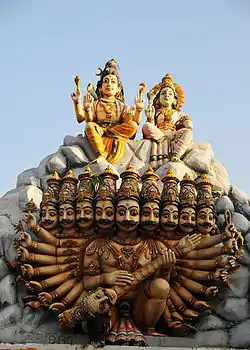
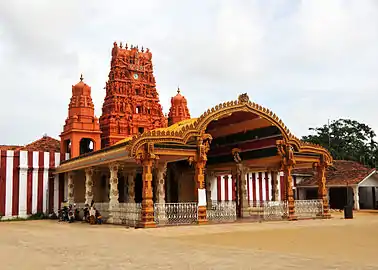 Front entrance of Nallur Kandaswamy temple
Front entrance of Nallur Kandaswamy temple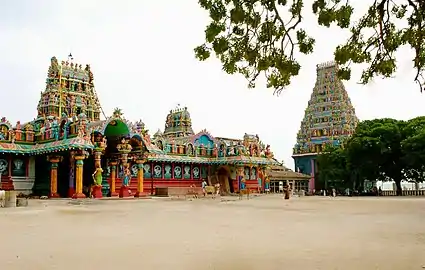
See also
Notes
- According to several authors, they may have been Dravidians.[9][10]
References
- "Census of Population and Housing, 2011". Sri Lanka: Department of Census and Statistics. Retrieved 29 August 2020.
- Walking to Kataragama, Sunil Goonasekera, International Centre for Ethnic Studies, 2007, p. 520.
- Obeyesekere, Gananath. “Social Change and the Deities: Rise of the Kataragama Cult in Modern Sri Lanka.” Man, vol. 12, no. 3/4, 1977, pp. 377–396. JSTOR, www.jstor.org/stable/2800544. Accessed 30 Jan. 2021.
- Lion of Lanka.
- "Shivaya Subramaniam". Himalayan Academy.
- The Book of Shiva, Namita Gokhale, Penguin Books India, 2009, p. 104.
- Meeadhu, Kalabooshanam (13 June 2008). "Nainativu Nagapooshani Chariot festival". Archived from the original on 4 June 2011. Retrieved 18 January 2011.
- Holt, The Sri Lanka Reader: History, Culture, Politics & Duke University Press, 2011, pp. 73-74.
- Laura Smid (2003). South Asian folklore: an encyclopedia: Afghanistan, Bangladesh, India, Pakistan, Sri Lanka. Great Britain: Routledge, p. 429.
- Chelvadurai Manogaran (1987). Ethnic conflict and reconciliation in Sri Lanka. United States: University of Hawaii Press, p. 21.
- templepurohit.com - May 28, 2015
- Asian Religions in British Columbia, UBC Press (2011), p. 125.
- "Buddhism among Tamils. An Introduction" (PDF).
- Lecture on Hindu sculpture and architecture of Sri Lanka Archived 2012-10-12 at the Wayback Machine Sunday Times - September 29, 2010
- Gilles Flament (July–September 2003). "Walking on Fire". Hinduism Today. Archived from the original on 26 March 2006.
- "Reach out to the minority" (PDF).
- "Census of Population and Housing of Sri Lanka, 2012" (PDF). Department of Census & Statistics, Sri Lanka. Archived (PDF) from the original on 2 April 2015.
- http://www.statistics.gov.lk/PopHouSat/PDF/p7%20population%20and%20Housing%20Text-11-12-06.pdf
- http://www.statistics.gov.lk/PopHouSat/PDF/p5%20Population%20and%20Housing%20Schedule.pdf
- https://web.archive.org/web/20071007215109/http://www.statistics.gov.lk/Abstract_2006/Tables/chap%202/AB2-13.pdf